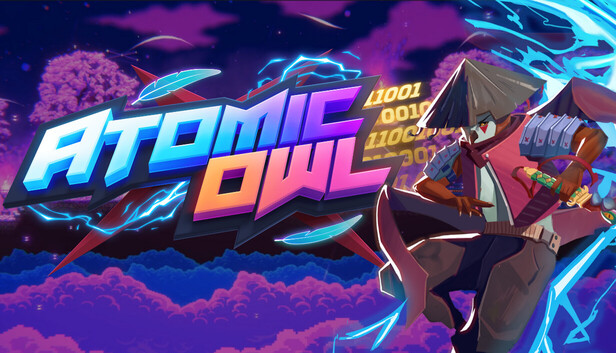FRONTLINE
I sat down with Eldar Basic about Atomic Owl. I cut a video from that chat to distill his points—tight, but with some heart. This is the written pass: the one where I sit inside his decisions and ask the annoying questions you only ask yourself at 1 a.m., when you should be asleep.
“I’m not backed by a mega publisher… I want my perspective to be from a place of honesty. Real numbers. Real challenges.”
Good. Let’s be honest.
Schedule the Boring

Atomic Owl
The first thing you meet isn’t a player—it’s work that doesn’t look like “making a game.” Company filings. Store checklists. Build pipelines. A calendar that punishes drift. It’s unglamorous and completely non-optional.
The only way any game actually ships is to split the week in two and mean it. Not as a vibe—as a boundary.
Company — filings, payments, contracts, platform setup, QA checklists, page copy, trailer thumbnails, keys, outreach.
Craft — story, level flow, enemy tuning, juice, code review, playtests.
On paper that’s tidy. In real life it’s you, mid-scroll, switching from a jump-arc tweak to a state form because a polite email just arrived: “$300, please.” Then a quarterly surprise—$180. Then Steamworks asking for a thing you didn’t know had a name yet. You learn quickly that the work behind the work lands before a single wishlist ping.
So you start naming days, because unnamed days get eaten alive.
Company days open with a ledger and a checklist. Did we file? Do we owe? Are the store assets actually the right dimensions? (Capsule, library, screenshots, trailer hook at 0:03, yes, that specific.) Do we have depots set up? Steam Input wired? Cloud saves behaving? Who gets keys—and how do we track them so the internet doesn’t siphon our launch?
Craft days are the antidote: headphones on, block the world, write the thing that makes the next hour worth the last eight. Move a platform three pixels and feel the whole level snap into place. Say “no” to features that are pretty and useless. Say “yes” to the boring micro-timings that make a dash feel earned. Then playtest until your own muscle memory is no longer lying to you.
Indie isn’t “do everything”—it’s own the outcome. Owning it means you make time for the unsexy, and then you protect the headspace that makes the game feel like a game. Most days you’ll use both halves of your brain—producer at 10:00, creative director by lunch, human brake pedal by 5. Eldar was blunt about it: you end up using the left and the right side of your brain—every day. And if you drift, the system will gladly eat you. His line keeps ringing in my head:
“Game development is a disaster for procrastinators.”
So you build small rituals that bully you toward progress. A morning “company stand-up” with yourself where you pay the invoice and close the tab. A “craft lock” where Slack dies and only the editor lives. A shutdown checklist so tomorrow isn’t a mystery. Boring on purpose—because boring is what lets the fun survive.
Before you chase wishlists, build a week that can carry the weight. Once the week has a spine, the next question gets louder:
Okay—what does the money say back?

Kickstarter first, because that’s the fantasy door everyone knocks on. Yes, they raised $56,000—but only after doing the part most of us avoid: not less than ≥500 real followers, ad money ready, and months of list-building so Day 1 wasn’t a prayer. Eldar’s take is simple enough to tattoo: “It’s not just pressing Go… it’s cultivating people so they’re there when you do.”
So—great. A “successful Kickstarter.” Woo hoo! We can make a game now, right?
Not so fast.
The spreadsheet doesn’t care about the confetti. The early plan said $40,000. The real bill drifted toward $135,000. Where did it go?
Taste, iteration, and people. One weapon became four because combat asked for it. A home base appeared because the loop needed a breath. Hiring shifted, and each change shaved a few weeks off the calendar you thought you owned. None of that is scandalous. It’s just the receipt for the version you can live with.
Which leads to the next late-night question: if it costs that much, how do you price it?
Feelings said $20. And feelings matter—until they meet a checkout button.
Eldar’s line here is very human: “You shoot your shot, right?” The market shrugged.
Wishlist→buy conversion hovered around ~4%. Players were basically whispering the answer you didn’t want to hear: this isn’t a $20 game; it’s $12–14.
And the cash register? After Steam’s cut, Atomic Owl has returned about $13,000 so far.
That’s not a tragedy; that’s a test result. You can love your $20 feeling—you just can’t invoice the audience for it.
There’s also pride and ethics to hold. ~1,000 people already paid $20. Eldar doesn’t want to cheapen their early bet by yanking the price now. So Steam stays where it launched, for the moment. But the next doors—PlayStation, Switch—are blank slates.
That’s where the experiment happens. Same game, same honesty, different sticker. Let the platforms answer back.
The Aftermath

So: the week has a spine, the money has spoken, and pride stings a little. What now? You don’t add six more features out of panic. You change the field you’re playing on.
The plan Eldar laid out isn’t heroic; it’s disciplined.
Patch fast, market longer. Give the game a year to eighteen months of steady, boring beats—updates, sales windows, community touchpoints—across six or seven storefronts. Steam isn’t the only judge. Atomic Owl has reached about a thousand people there. The goal isn’t to resurrect on that single hill; it’s to find a hundred thousand across all hills: PlayStation, Switch, GOG, Epic… each with its own audience, its own seasonal rhythms, its own discount culture. Launch stops being a verdict and becomes a runway.
Price becomes part of distribution, not ego. Keep Steam at $20 to respect early buyers, fine. But when you step onto console, you carry the lesson with you—lead at $12–14 and watch the needle. Same game, different sticker, new test. This is not a betrayal of the “vision”; it’s respect for the market that funds the next vision.
And if attention is tight (it will be), you sell the skill you sharpened building your own thing. That’s what their “publishing” arm really looked like in practice: not a cheque, but manpower.
They took a small viral itch game and did the jobs its creator couldn’t face right then—wrapping the build, wiring Steam Input and Cloud, pushing to Steam and GOG.
The rule is simple: be useful in the gap that moves the project. Cashflow isn’t only sales; sometimes it’s shipping value for someone else while your audience finds you.
None of this reads like the movie version. It reads like work. A calendar instead of a crescendo. A price test instead of a miracle. A porting sprint instead of a tweet going viral. But that’s the point. When the math doesn’t love you yet, you don’t wait for love—you engineer more chances to be loved.
So that’s the plan: patch, distribute, price like a scientist, sell the skills you’ve sharpened. It’s not romantic. It’s adult. And once you accept that, what you want next isn’t another pitch—it’s a handful of short answers you can pin to the monitor and actually use tomorrow.
Pocket Rules

TOOLS I CAN’T SHIP WITHOUT
One brain for the team: Jira and Confluence. If it isn’t written down, it isn’t real. The second brain is borrowed time: Buffer. Schedule a month of posts for the price of lunch; in Eldar’s words, “they could charge me $200 a month. I’d pay that.” It’s not about social growth—it’s about freeing a day you can spend fixing a level that still lies to you.
BEST SUB-$200 SPEND
Buy other people’s games and study them like R&D. Not to steal—to name what feels good: acceleration curves, camera forgiveness, the way a jump exits the frame without nausea. Record 30 seconds, rewatch at half speed, write the principle, not the feature. Repeat until your hands learn the lesson.
ADMIN TRAP I WON’T REPEAT
The curator key farm spiral. Verify outlets, track keys, stop emailing the void. PR time is oxygen—don’t pour it into a sieve. And, don’t send reviewers a build you hope they’ll forgive. They won’t. “Send the game out when it’s done.” That line is cruel until you obey it; then it’s mercy.
I don’t think the headline is that indie is hard—everyone knows that. The headline is that you can plan for the hardness: name your days, price like a scientist, sell the skills you’ve earned, and keep changing the field you’re playing on until the audience finds you. If any of this saves you one invoice, one wasted week, or one stubborn price point—good. Tape it to your monitor and get back to the build.
FOLLOW ELDAR AND WHAT HE’S CREATING:
The Indieformer Team
Thanks for reading — and if you ever want to chat games, marketing, or the weirdness of the indie grind, we’re always lurking on Threads, BlueSky and X. Come say hi.
We’ve also put together a few free guides to help indie devs get their projects in front of the right people. You can view them anytime: Steam Marketing Guide, Press Kit Guide.


